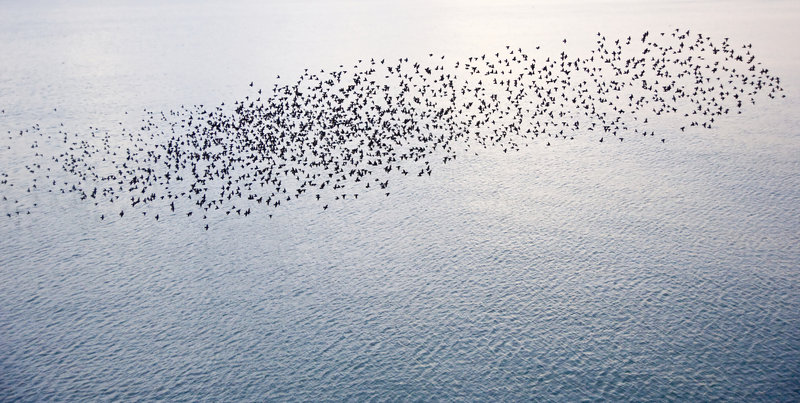I have been watching some of the large flocks of European starlings wheeling through the air around dusk as they prepare to go to roost for the night.
I’m sure you have seen this behavior too. The flocks (called murmurations) form in the fall after the breeding season and will persist until next spring.
A flock in flight seems to have a collective mind of its own as the birds change direction, often in unison. It is remarkable that birds don’t fly into each other as they perform their aerobatic maneuvers.
Thanks to the work of two Italian ornithologists, Michele Ballerini and Andrea Cavagna, we have a better understanding of the synchronized flight of these murmurations.
Ballerini and Cavagna used a series of interlinked cameras to record murmurations in flight. A computer assimilated the data from the cameras to produce a three-dimensional map of all the birds in the flock.
The researchers easily disproved the notion that there is a leader in the flock. Rather, birds seem to follow a couple of rules: fly in the same direction as your neighbors and keep your neighbors by your side rather than in front or behind.
Like most birds with eyes set on the side of the head, starlings have a blind spot behind the head and directly in front as well. The best vision is off to the side.
We know that starlings can change their direction in 100 milliseconds!
The videotapes clearly showed that the spacing of the birds in the murmuration is not uniform. Birds in the middle of the flock are spaced closer together. Furthermore, birds change their position in the flock, sometimes on the outside and sometimes moving in.
Flying together seems to confer protection from aerial predators like falcons or accipiters, much like small marine fish flock as protection against barracudas. The idea is that the many individuals are confusing to the predator.
Woe unto the bird or fish that turns right when all the others turn left in the presence of a predator. It becomes easy pickings for the predator. So, the safest portion of a flying murmuration is in the middle.
It’s not surprising that there is a tendency of birds on the edge to fly toward the center. This movement has been termed selfish flock behavior.
These aerial ballets have only been performed in North America for the past 120 years or so. European starlings are an introduced species in the western hemisphere. Their presence here is due to a man named Eugene Schieffelin.
Schieffelin was a rather prosperous Englishman who moved to New York City around 1880. He thought it would be wonderful if Central Park had populations of all the birds mentioned in Shakespeare’s plays.
The first species he introduced was the European starling, starting with around 100 birds in 1890 and 1891.
His introduction was far more successful than he ever could have imagined. From those 100 birds, a population of more than 200 million birds now stretches across the continent.
The introduction of starlings has had negative impacts on our native birds.
A starling’s all-purpose bill allows it to take a wide variety of food (seeds, fruit, invertebrates). Starlings can compete for food with many types of birds.
In addition, starlings are cavity-nesters and their aggressive battles for nesting cavities has negatively affected native cavity-nesters.
Eastern bluebirds, tree swallows and woodpeckers clearly have declined as starlings have increased.
Competition for cavities by starlings has affected other cavity-nesters as well, like tufted titmice and nuthatches.
Providing nest boxes with diameters too small for starlings to enter can ameliorate the problem.
Herb Wilson teaches ornithology and other biology courses at Colby College. He welcomes reader comments and questions at:
whwilson@colby.edu
Send questions/comments to the editors.



Success. Please wait for the page to reload. If the page does not reload within 5 seconds, please refresh the page.
Enter your email and password to access comments.
Hi, to comment on stories you must . This profile is in addition to your subscription and website login.
Already have a commenting profile? .
Invalid username/password.
Please check your email to confirm and complete your registration.
Only subscribers are eligible to post comments. Please subscribe or login first for digital access. Here’s why.
Use the form below to reset your password. When you've submitted your account email, we will send an email with a reset code.